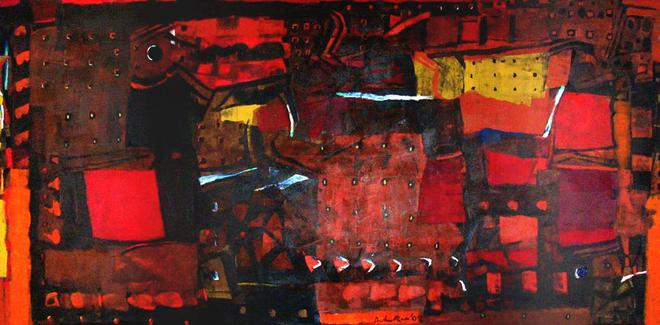Achuthan Kudallur was endearingly grouchy on the phone. He called intermittently and hung up abruptly, forgoing superfluous niceties for disarmingly honest conversations on family, art and life. Not surprisingly, the reclusive artist who passed away on Monday morning at a hospital in Chennai, is mourned by a large group of friends, family and fans.
He will be remembered for his prodigious talent, of course. Aged 77, Kudallur was a significant force in India’s contemporary abstract art movement. A writer-turned-painter, his luminous canvases, pulsating with colour, drew international attention to the Madras Art Movement in the 1970s. He won multiple awards, including the Tamil Nadu Lalit Kala Akademi award in 1982 and the National Academy Award in 1988 and exhibited his work widely, both nationally and internationally.
He is also remembered for his unexpected patience and willingness to mentor talent — from hopeful young artists and gallerists to his staff’s children, whom he dotingly allowed to run amok between his canvases at his house by the sea in Thiruvanmiyur.
For an artist seen as temperamental and brusque — a persona he never bothered to contest — Kudallur was also sensitive, empathetic and kind, though he attempted to hide it behind a gruff demeanour and dark sense of humour.
Artist C Douglas, from Cholamandal Artists’ Village, says it is these facets of his personality that make his work so impactful. “Like him, his canvases have layers and layers, not one single mass of colour,” he says.
Douglas talks with admiration of how the painter balanced local and meta narratives in his work: “Though his work is abstract, there is universality to it, because its his personal expression. His art has a clarity that touches the world, somehow.”
Born in 1945, in Kudallur village, Kerala, Kudallur’s work is deeply influenced by an idyllic childhood, swimming in the Bharathapuzha and Kunthipuzha rivers that intersected beside his childhood home. He moved to Chennai in 1965, to study civil engineering, where he joined evening classes at the Madras Art Club in Government College of Fine Arts.
Artist RB Bhaskaran, former chairman of Lalit Kala Akademi and former principal of the Government College of Fine Arts, Chennai and Government College of Arts, Kumbakonam, knew Kudallur as a student, an artist and a friend. “I took still life classes at the Madras Art Club and from the time I saw his first abstraction, I told him he has talent,” says Bhaskaran, adding that the painter, who was working at the Public Works Department in Chepauk, wanted to become a writer at that point, and was already being published in Malayalam. “He is a very good colourist,” says Bhaskaran, adding that Kudallur’s strength is balancing colour with light.

Between work and art classes, Kudallur began to find his style as he moved from figurative to abstract art in the late 1960s and early ‘70s. Derisive of money — a life-long trait — he gave up his job, and began to make his own canvases with thick cloth, coats of glue, zinc oxide and white lead so he could paint. Part of an idealistic fraternity of writers, artists and filmmakers, he would often talk fondly of drinking tea in Triplicane on midnight strolls and spending the whole night on the beach.
Living alone, by choice, he retained vestiges of this early bohemian life, tempered with the cautiousness of old age, taking walks on the beach and falling asleep occasionally on his terrace. The colours he worked with changed with his moods, and though his yellows, greens and blues are also sought after by collectors, he retained a special affection for his strong red canvases, bright vortexes of energy in acrylic on canvas, puddled with oases of calm.
Artist, film art director and production designer Thota Tharini who has exhibited with Kudallur on group shows and is a friend of the artist, talks of how his passion for art was evident in his work. “He was not just patching up colour, but painted with sincerity,” says Tharini, praising the composition of the colours.
Though his paintings kept increasing in value, Kudallur showed little interest in sales, preferring instead to expend his bursts of energy on his art, in a home chaotic with canvases, palettes, paints and easels. Instead, he left the details to the few people he trusted, mainly Mayur Shah, at Chennai’s Focus Gallery, with whom he shared a warm friendship.
“I would ask him how to interpret his work, and he would say ‘Interpret what you want, why do you want to know what I think?,” says Shah, adding that Kudallur constantly urged him to display the work of younger artists. “He saw great talent being suppressed everywhere, so he was proudest when we promoted relatively unknown names,” he says, adding, “He would go to their shows and always buy a painting to encourage them.”
“I always called him an angry young man,” says Douglas affectionately. “I would say that anger gives him youth... But, somehow, he couldn’t keep that anger as he got older, it made him soft.”







